We sincerely hope that you enjoy this article about Earth’s Many Magnificent Marsupials. These remarkable creatures have long fascinated mankind. Of course, these few represent only a small percentage of the 334 known species of marsupials in the world. But we hope that reading and learning of these examples of Earth’s Many Magnificent Marsupials serves to whet your appetite to learn and discover about the others, found throughout the whole of our beautiful world.
Numbat
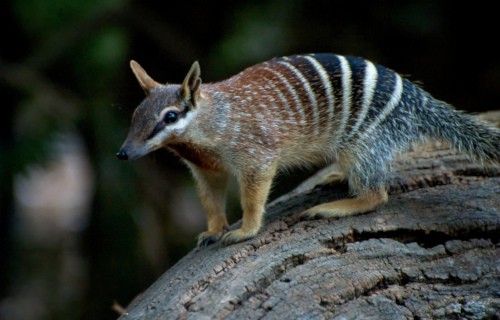
CCL: https://bit.ly/32gyQe5
Numbat Facts
- Leading off this article about Earth’s Many Magnificent Marsupials is the amazing creature known simply as the Numbat.
- The truly amazing animal remains perhaps one of the least known of all marsupials. The remarkable creature also goes by the other common names of the walpurti or the noombat. This fascinating animal further bears the somewhat cumbersome scientific name of Myrmecobius fasciatus.
- However, regardless of the name one calls it by, it represents a most unusual animal in several ways. First of all, it represents one of the few known marsupials to have an entirely insectivorous diet. The great majority of its related species feed as either herbivores, carnivores, or omnivores.
- Secondly, this incredible mammal distinguishes itself from similar species in yet another manner. In this instance, this occurs in regards to its pattern of activity. That’s because the marvelous Numbat remains the only known marsupial in the world to have a completely diurnal pattern of behavior.
- This surprising animal first became known to Europeans in 1831. At that time, it inhabited a comparatively broad natural range. Unfortunately, however, that no longer remains the case. It currently only inhabits a highly restricted and limited range, constituting only a fraction of its previous territory.
- Quite fortunately, its remaining native habitat range encompasses two protected locations. This offers the surviving individuals a measure of protection. In addition, a few individuals of this example of Earth’s Many Magnificent Marsupials have also been reintroduced into a few small reserves. Due to these factors, the IUCN currently list the animal as Endangered.
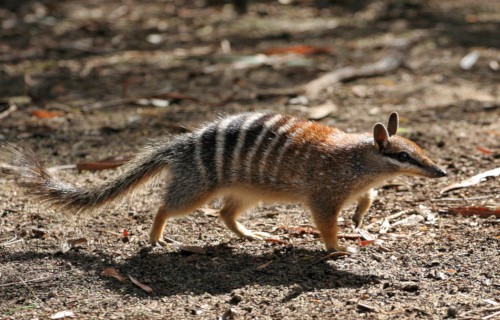
CCL: https://bit.ly/38Qf9w9
Numbat Physical Description
While the awesome Numbat certainly is amazing, the fascinating animal does not earn this consideration due to its physical size. That’s because the mammal actually ranks as a comparatively small variety of marsupial. It also displays a moderate degree of sexual dimorphism. In its case, this presents itself in the fact that females attain a slightly smaller average weight than the males of the astounding species.
However, despite the difference in weights, both genders of the Numbat attain roughly the same body length. That remains true due to the fact that both sexes reach a maximum body length of about 11.4 in (29 cm). Further, the tail adds an average of 6.5 in (16.5 cm). Yet the males of this species typically weigh roughly 1.3 lb (0.59 kg). But, exceptional males may weigh up to 1.66 lb (0.75 kg). Meanwhile, females average 1.05 lb (0.48 kg), with exceptional individuals weighing as much as 1.49 lb (0. 68 kg).
Yet, the colors vary significantly between individuals of both genders. These range from reddish-brown to a soft gray color. In addition, a region of dark red appears of the upper back. An obvious black stripe also extends from the sharply pointed muzzle to the base of the ears. Oddly, a series of white stripes also cross its hindquarters. These range in number from 4 – 11, depending on the individual. The underbelly of the animal displays either a light gray or a cream color. The tail has a covering of long grayish-white fur.
- Kingdom: Animalia
- Phylum: Chordata
- Class: Mammalia
- Order: Dasyuromorphia
- Family: Myrmecobiidae
- Genus: Myrmecobius
- Species: M. fasciatus
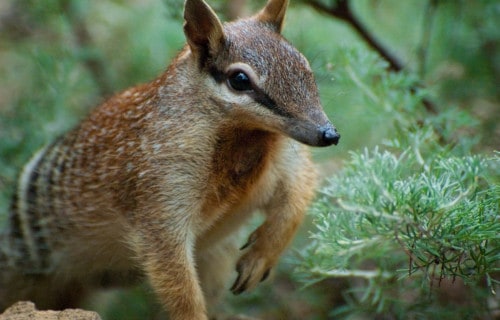
CCL: https://bit.ly/2ujDQBZ
Numbat Distribution, Habitat, and Ecology
Perhaps most notably, the wonderful Numbat, quite sadly, now inhabits only a fraction of its original native range. Prior to European discovery and habitation of the continent, it thrived throughout much of Australia. Now, however, its territory consists solely of two protected areas in the western regions, and several preserves. These latter locations remain quite widely scattered through the west and south parts of the continent, as well as one located in New South Wales.
Prior to the human-caused reduction of its range, the remarkable Numbat lived mainly in regions of grasslands and both arid and semi-arid woodlands. Now, however, it only lives in areas of eucalyptus woodlands. Further, even there it inhabits an extremely specific altitude range. This holds true due to its presence being restricted to protected areas. These all have an altitude measuring roughly 1,040 ft (317 m). This further consists of extremely moist forest regions.
Since it remains solely active during the day, the Numbat typically spends its night in yet another highly specific location. This consists of fallen hollow logs. Herein, the animal studiously avoids the majority of its natural predators, mainly consisting of foxes and large birds. It itself, in an unusual trait among its related species, feeds exclusively on termites. This further restricts its habitat range to locations with a large presence of this insect, since each individual consumes an average of 20,000 termites per day.
Tasmanian Devil
Tasmanian Devil Facts
- The next animal chosen to list on this compendium of Earth’s Many Magnificent Marsupials is the often maligned Tasmanian Devil.
- Most notably, the fabulous animal long ago became a symbol of aggressiveness and savage behavior. While fact often becomes mistaken for fiction, in its case this symbolism is indeed based in fact. That’s because it does tend to have an extremely aggressive nature.
- Furthermore, the impressive creature also represents a most unusual type of animal. That holds true because the remarkably animal classifies as a carnivorous marsupial mammal. Further, the animal also presently ranks as the largest such species still in existence.
- Sadly, however, the Tasmanian Devil may not hold that particular distinction for long. It once appeared numerous throughout a comparatively wide range of habitation. However, the creature now exists almost exclusively in only one isolated location in the world.
- Further, its population numbers dwindled dramatically during the 19th and early 20th centuries. But, the unique mammal finally became a protected species in 1941. Consequently, the population of the species slowly began to recover, at least for a period of time.
- But, beginning in 1996, a new, and serious threat emerged. At that time, a bizarre disease began to ravage the population. Causing severe facial tumors, it eventually prevents feeding, and leads to starvation. Due to the consequences, the IUCN now lists it as Endangered.
Tasmanian Devil Physical Description
Firstly, although the Amazing Tasmanian Devil ranks as the largest animal of its kind, its nevertheless remains relatively small. The magnificent animal does, however, display a moderate degree of sexual dimorphism. In its case, the males attain a slightly larger size than the females.
This holds true due to the fact that males typically develop a head-and-body length of about 25.7 in (65.2 cm). Furthermore, the tail of the creature usually averages a length of roughly 10.2 in (25.8 cm). In addition, in terms of weight, the males of the species generally average about 18 lb (8.16 kg).
Yet the females of the species, on the other hand, usually only reach about 22 in (57 cm) in head-and-body length. Further, the same females also develop a tail averaging 9.6 in (24.4 cm) in length. But, in terms of weight, these same females only typically reach a weight of about 13.2 lb (6 kg).
Additionally, in both genders, the front legs usually grow somewhat longer than the rear legs. This gives the Tasmanian Devil quite a distinctive gait. In addition, the fur usually presents mainly black. But, uneven white spots or splotches also sometimes appear on the rump and chest of the mammal.
- Kingdom: Animalia
- Phylum: Chordata
- Class: Mammalia
- Order: Dasyuromorphia
- Family: Dasyuridae
- Genus: Sarcophilus
- Species: S. harrisii
Tasmanian Devil Distribution, Habitat, and Ecology
First of all, as the name implies, the remarkable Tasmanian Devil remains indigenous to the island of Tasmania. Though once present on the mainland of Australia, this now serves as home to all but a handful of individuals in the wild. The only others exist on a tiny island joined to it at high tide.
In addition, within that tragically limited range, however, the mammal proves itself to be highly adaptable. As a result, it presently inhabits every type of habitat present on the island. This often even includes the outlying portions of urban areas. This, however, often proves to be to its detriment.
This carnivore also evolved as both nocturnal and crepuscular in nature. Additionally, the prey of the Tasmanian Devil sometimes includes animal as large as small kangaroos. But, it most commonly prefers to hunt smaller prey. Further, being opportunistic, it actually eats carrion more than it hunts.
Finally, its reputation for aggressive behavior remains quite well deserved. That holds true due to the fact that, mainly living a solitary life, except for mating, males often fight savagely during encounters. Finally, even its mating habits have been referred to as extremely vigorous in nature.
Tree Kangaroo
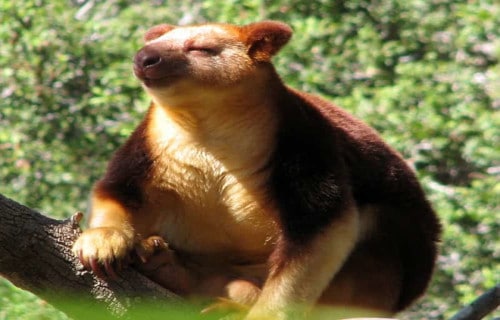
CCL: https://bit.ly/1iowB8m
Tree Kangaroo Facts
- The third animal appearing in this compilation of Earth’s Many Magnificent Marsupials is the astonishing Tree Kangaroo.
- Firstly, the surprising term serves as the collective common name for about 12 separate species in the genus Dendrolagus. The uncertainty about the number of member species arises from differences of opinion regarding classification among scientists.
- Further, all members of this remarkable genus have one outstanding trait in common. That’s because the various species in the genus actually evolved as arboreal creatures. In addition, this group or remarkable animals remains the only known arboreal macropods.
- Individuals of the various species all typically remain very slow and clumsy on the ground. Additionally, the surprising mammal moves haltingly, and hops awkwardly. However, in the trees, it actually appears to be extremely agile and a surprisingly effective climber.
- This fantastic creature also ranks as an amazingly powerful leaper, much like its terrestrial counterparts. It has been seen to jump as much as 30 ft (9 m) from one limb to another. In addition, it can also jump to the ground from as high as 59 ft (18 m) without incurring injury. Truly, one of Earth’s Many Magnificent Marsupials.
- Quite unfortunately, the IUCN currently lists the majority of known members in this incredible genus as Threatened. This listing appears in its Red List of Threatened Species. The reasons for this include habitat loss and hunting. But, the Tree Kangaroo also now faces the danger of climate change.
Tree Kangaroo Physical Description
The truly astonishing Tree Kangaroo continues to amaze us. That’s partly due to the fact that the animal evolved several adaptations extremely useful for an arboreal life. For one thing, its back legs grow significantly broader and shorter than those of its terrestrial cousins. This provides better balance.
Furthermore, the incredible creature also possesses quite long, and extensively curved nails on those rear legs. However, these serve a far more important purpose than mere aesthetics. That because the magnificent mammal routinely, and quite effectively, uses these for gripping and climbing.
But the differences between it and related species does not end there. That’s due to the fact that the Tree Kangaroo also has a much broader and longer tail than a terrestrial kangaroo. This evolutionary divergence provides the fascinating animal with an enhanced balance while moving through the canopy.
In addition, much like terrestrial kangaroos, it remains physically incapable of sweating, to cool its body. Nevertheless, the mammal developed an alternate method of thermo-regulation. That’s because, instead of sweating, it licks its forearms and allows the moisture to evaporate, thereby cooling it.
- Kingdom: Animalia
- Phylum: Chordata
- Class: Mammalia
- Order: Diprotodontia
- Family: Macropodidae
- Genus: Dendrolagus
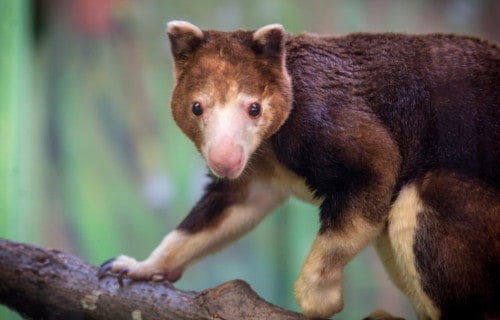
CCL: https://bit.ly/1jxQJMa
Tree Kangaroo Distribution, Habitat, and Ecology
Unfortunately, the only known forms of the surprising Tree Kangaroo inhabit a highly restricted and vulnerable region of the world. This consists primarily of the rainforest regions of New Guinea, parts of Queensland, Australia. However, the majestic creature does also appear on a few local islands.
Yet, within this range, the various species within the genus understandably have different habitat preferences. First of all, the majority of the different species in the genus prefer to live in montane areas. Secondly, though, there nevertheless remain several varieties that prefer to dwell in lowland areas.
In addition, this stunning animal has even more specific habitat requirements. That’s because of the fact that it thrives in treetops, instead of the ground like its genetic cousins. Also, the reason it somehow managed to adapt better to regions of high altitude than its terrestrial cousins remains a mystery.
The animal also breeds during the monsoon season. Tree Kangaroo matings produce only one young per litter. Its primary predator seems to be the amethystine python, which also inhabits the same canopies. Also, being herbivorous in nature, its own diet consists principally of fruits and leaves.
Sugar Glider
Sugar Glider Facts
- Appearing next among these choices of animals to represent Earth’s Many Magnificent Marsupials the wonderful Sugar Glider.
- Firstly, the term distinctive term names a small and quite adorable species of flying marsupial. Despite a slight resemblance, it has no relationship to flying squirrels but actually remains a type of possum.
- Secondly, the common name for this remarkable animal actually derives from two factors. The first is its tendency to glide through the air, while the other remains its affinity for sugary foods during the winter.
- Despite a reduction of indigenous habitat, its numbers thankfully appear to be continuing to remain steady. For this reason, the IUCN has listed the Sugar Glider as a Species of Least Concern on its Red List.
- Further, these fabulous small creatures have proven themselves to be extremely resilient to change. That’s because, for the moment, the animal appears to be able to survive in small, isolated patches of forest.
Sugar Glider Physical Description
Perhaps most notably, the Sugar Glider has a thin, elongated body shape. This gives it a shape similar to that of a squirrel. This coincidental physical resemblance often leads to the common confusion many people experience.
Sexual Dimorphism also appears in this species, like many others. In its case, males typically grow slightly larger than females. Females average 12 in (30.5 cm) in body length. But males reach roughly 13 in (33 cm) in total size.
In addition, the tail grows relatively long and partially prehensile, like many possums, and the fur develops thick and soft. In color, individuals typically present a combination of blue-gray, yellow, and tan on the back and sides.
The natural coloring of the Sugar Glider also present a striking image. That’s because its underbelly typically has a cream color. Meanwhile, a large black stripe generally appears from the nose to midway down the length of the back.
Furthermore, the eyes also remain large and set far apart. In addition, a thin membrane extends from each front foot to each hind foot. When extended, this membrane allows the animal to glide from branch to branch.
- Kingdom: Animalia
- Phylum: Chordata
- Class: Mammalia
- Order: Diprodontia
- Family: Petauridae
- Genus: Petaurus
- Species: P. breviceps
Sugar Glider Distribution, Habitat, and Ecology
While the awesome Sugar Glider evolved in a restricted habitat range, where that is comes as no surprise. Not surprisingly, it evolved as endemic to Australia and parts of Tasmania, New Guinea, and numerous islands in the region.
Also, most individuals typically inhabit regions at altitudes measuring up to 6,562 ft (2,000 m). Being highly adaptable, it most commonly appears in either temperate forests or rainforests. But it also sometimes appears in regions of scrub.
These arboreal creatures remain principally nocturnal in nature. They further seem to be seasonally-adapted omnivores. During the Spring and Summer, it feeds as an insectivore. During the winter, however, the Sugar Glider feeds on the gum and sap of various plants.
Its primary predators include snakes and owls. The marsupial also evolved as highly social creatures, commonly living in small groups or colonies. Reproduction occurs 1-2 times per year, depending on environmental conditions. A typical lifespan in the wild measures about 9 years.
Quokka
Quokka Facts
- The astounding Quoka appears in the fifth spot on this list of Earth’s Many Magnificent Marsupials, but only due to random selection.
- Firstly, the truly fabulous animal represents an extremely unique animal in the genus Setonix. Further, the remarkable creature sits alone in that genus. In addition, this beautiful small marsupial also remains quite renowned for its highly distinctive natural expression.
- Secondly, the IUCN presently lists the diminutive creature as Vulnerable, on its Red List of Threatened Species. The amazing creature also represented one of the first mammals to be seen by Europeans. That’s because that sighting and description occurred as early as 1658.
- Quite unfortunately, however, only a few scattered concentrations of the animal seem to exist within its natural habitat range. It also remains undetermined if this animal once possessed a more extensive area of habitation. Presently, scientific research into this remains ongoing. Truly, one of Earth’s Many Magnificent Marsupials.
- Finally, this fantastic marsupial also possesses an extremely docile and outgoing demeanor. Unlike nearly all other wild animals, individuals of this species in the wild openly approach humans when encountered. Sadly, this sometimes works against the remarkable Quokka.
Quokka Physical Description
Perhaps most notably, the incredible Quokka attains only a moderate physical size. That’s because the animal reaches a size roughly equal to that of many species of domestic feline. In fact, its body typically measures about 21 in (54 cm) in length.
Furthermore, the tail of this species grows comparatively short for a macropod. That’s due to the fact that it only averages about 12 in (30 cm) long. In addition, exceptional individuals weigh up to 11 lb (5 kg), though most average perhaps half of that.
Additionally, the overall build of the Quokka develops as relatively stocky in shape. The head also generally develops relatively broad. Added to this is the fact that the ears appear rounded in shape. Its fur also grows course and generally dark brown to light brown.
- Kingdom: Animalia
- Phylum: Chordata
- Class: Mammalia
- Order: Diprotodontia
- Family: Macropodidae
- Genus: Setonix
- Species: S. brachyurus
Quokka Distribution, Habitat, and Ecology
Quite sadly for those who love Nature, the amazing Quokka currently only inhabits an extremely limited range of the world. That’s because the few small populations of the amazing animal known to still exist remain primarily confined to several small islands situated off the coast of Western Australia.
Yet, a few other small, isolated populations of the mammal do occur in other locations. However, only one colony is known to exist on the mainland of the continent. Also, this small population of the marvelous Quokka dwells within the confines of Two Peoples Bay Nature Reserve.
Though fully capable of climbing trees, the animal prefers to inhabit areas of dense ground cover. This it uses for protection from predators. This remarkable animal remains primarily nocturnal by nature. It evolved as herbivorous in nature and feeds predominantly on endemic flower species.
Finally, it also faces other serious threats besides its limited habitat range. In point of fact, combined with the highly limited territorial range, the primary threat to its existence comes from introduced predator species. These non-native threats it now faces primarily include cats, dogs, and foxes.
Opossum
Opossum Facts
- Out o all the creatures among these choices to represent Earth’s Many Magnificent Marsupials, the Opossum has perhaps the worst reputation.
- Firstly, a total of 103 varieties of the animal known as the Opossum exist. The one pictured here represents the Virginia Opossum. It is native to the Virginia region of the United States, in North America.
- In addition, it also served as the first of the 103 species to be given the well-known common name. Further, the name itself came from the native language of the local Algonquin tribe of Native Americans.
- Moreover, the species has particularly unspecialized biology, flexible diet, and an impressive reproductive strategy. This makes it a successful colonizer and adapter to diverse locations and conditions.
- This particular Opossum also remains one of three mammals which share a highly unusual record. That’s because they share the record for the shortest gestation period on earth, numbering only 12 days.
Opossum Physical Description
Quite understandably, the various forms of Opossum display physical variations. However, many basic characteristics remain true to all of them. Only a few of them display a noticeable degree of sexual dimorphism.
Furthermore, the varying species vary significantly in size. That’s becasue they have a head and body length ranging from 4.7 – 37 in (12 – 94 cm). However, the majority of the different types grow to about the size of an average house cat.
Further, most of the differing species under the collective name display a narrow head with a long snout. The feet also have long, extremely powerful claws. In addition, the back feet of the animal each have one opposable digit.
Although coloring differs between them, each species has one other physical trait in common. Like many monkeys, the tail remains quite prehensile, serving the resourceful Opossum in a myriad of useful ways.
- Kingdom: Animalia
- Phylum: Chordata
- Class: Mammalia
- Order: Didelphimorphia
- Family: Didelphidae
Opossum Distribution, Habitat, and Ecology
Most notably, all known species classified as types of Opossum inhabit the Western Hemisphere. Obviously, however, the choice of habitats vary among the different species. Yet the great majority inhabit temperate forests.
While individuals often occupy an abandoned burrow from some other animal, most do not dig their own. Moreover, most appear nocturnal in nature. Most prefer dark, sturdy locations for a nest, either below or above ground.
In addition, the resourceful Opossum also developed a highly unique defense mechanism. This strategy it employs when either harmed or threatened. At such a time, an involuntary physiological response takes effect.
Also, the surprising creature loses consciousness, and its body subsequently becomes exceedingly stiff. After this, its lips curl back, saliva foams from the mouth, and an extremely foul-smelling fluid is secreted from a special gland.
The seemingly-deceased animal may be prodded, poked, and even moved without any sign of reaction. The enterprising animal literally looks, feels, and even smells to anyone encountering it as if it has been dead for some time.
This physiological condition isn’t short-lived, either. That’s because it typically lasts for between 40-240 minutes. After this time, the animal slowly regains consciousness, and eventually returns to its normal activities.
In addition, it feeds as an opportunistic omnivore with a very broad diet. Most primarily feed on carrion, but also eat frogs, insects, birds, snakes, small mammals, earthworms, and slugs. It also seems quite fond of various fruits. Finally, the animal usually lives a solitary and nomadic life in nature.
Mountain Pygmy Possum
Mountain Pygmy Possum Facts
- Listing as seventh out of these examples of Earth’s Many Magnificent Marsupials is the Mountain Pygmy Possum.
- Most notably, the accidental discovery of fossil evidence of the quite reclusive marsupial occurred in 1895. In addition, this quite surprising discovery occurred in an isolated cave. Further, at that time, science believed the fascinating species to be extinct. However, an accidental discovery of a living individual occurred in the year 1966.
- In addition, this small but incredible creature seems to have adapted to a highly unique seasonal diet. Firstly, during the spring and summer seasons, the distinctive Mountain Pygmy Possum feeds exclusively on the bugong moth. Secondly, though, throughout the rest of the year, the amazing animal apparently feeds exclusively on various fruits and seeds.
- However, the sincerely remarkable mammalian species still appears to be extremely rare. Further, currently, only three small populations appear to exist throughout its entire range. Due to this, along with other factors, the IUCN currently lists the animal as Critically Endangered. Quite sadly, following a recent firestorm in the region, its current population remains unknown.
Mountain Pygmy Possum Physical Description
Despite its many amazing attributes, the Mountain Pygmy Possum constitutes a very small species of marsupial. First of all, the remarkable creature has an average weight of only around 1.6 oz (45 g). Additionally, the total length of the head and body only measures about 4.3 in (10.9 cm).
In addition, the tail of this intriguing animal grows surprisingly long, especially compared to other measurements. In point of fact, this appendage grows longer than the combined length of the head and body. Scientists currently remain uncertain as to the evolutionary reason for this trait.
Furthermore, this highly interesting creature also displays a small degree of sexual dimorphism. In this, the Mountain Pygmy Possum follows a pattern typical to its many related species. In its case, however, this involves the males typically growing to about 10% larger than the females in overall size.
Finally, its general appearance also distinguishes it from other species. For one thing, that’s because the eyes also remain comparatively large. In addition, the fur generally presents as gray to brown in color. Individuals often also possess a dark stripe on the back, and a pale one on each side of the body.
- Kingdom: Animalia
- Phylum: Chordata
- Class: Mammalia
- Order: Diprotodontia
- Family: Burramyidae
- Genus: Burramys
- Species: B. parvus
Mountain Pygmy Possum Distribution, Habitat, and Ecology
Quite sadly, the Mountain Pygmy Possum evolved as endemic solely to a tiny territorial range. This consists of the alpine areas of southern Australia. Furthermore, at this time, small populations exist perhaps on only three mountains. These consist of Mount Bugong, Mount Blue Cow, and Mount Buller.
Also quite uniquely, the two genders further separate themselves in yet another manner. That holds true due to the fact that the genders have different habitat ranges throughout most of their lives. As a result, individuals of the opposite sex usually encounter each other only during mating season. It’s one of the most reclusive of Earth’s Many Magnificent Marsupials.
First of all, the females typically dwell at altitudes of between 4,593-7,316 ft (1,400-2230 m). Meanwhile, the males prefer altitudes ranging from 3,937-4,265 ft (1,200-1,300 m). Nevertheless, within the separate ranges, both genders of the Mountain Pygmy Possum prefer to nest near rocky streams and formations of loose boulders.
Bandicoot
Bandicoot Facts
- Here we present the next of these representatives of Earth’s Many Magnificent Marsupials, the Bandicoot.
- Firstly, the term collectively serves as the common name given to a group of about 20 species. Scientists collectively place these varying species in the Order Peramelemorphia. Further, all of these particular species evolved as small to medium-sized marsupial omnivores.
- In addition, each of these 20 separate varieties in the fascinating Order evolved as endemic to a single continent. Nevertheless, the varying species of this animal typically attain different sizes. However, each of them remain comparable in overall size to the common rabbit.
- Furthermore, despite its small size, the amazing Bandicoot holds a surprise for many people. That holds true due to the fact that it can pose a rather severe health risk to both humans and other animals. This occurs due to its being a primary carrier of the disease known as Q fever.
- Finally, the surprising creature displays little of the shyness around humans presented by most wild animals. In fact, in populated areas, individuals boldly venture into backyards. In this, the fascinating animal has the same habits as the raccoons found in North America. Truly, it ranks as one of Earth’s Many Magnificent Marsupials.
Bandicoot Physical Description
Given the different species placed within the genus, one fact remains quite understandably present. That’s the fact that the appearance of various Bandicoot species can be quite different. However, many basic traits continue to be present throughout the entirety of the impressive Order.
Most notably, the trait of sexual dimorphism evolved as present within each species. Due to this, in most cases, the males can be nearly twice the size of the females. In point of fact, mature adults range in length from 11 – 31 in (28 – 78.75 cm). Further, these also weigh between 0.4 – 3.5 lb (0.18 – 1.6 kg).
In addition, the snout of the Bandicoot grows quite long, relative to body size. The back also develops a natural arch. Meanwhile, the tail remains long and thin, and the back feet develop much larger than the front feet. Additionally, its coloring is a random combination of white, brown, and gray.
- Kingdom: Animalia
- Phylum: Chordata
- Class: Mammalia
- Order: Peramelemorphia
- Family: Peramelidae
- Genus: Perameles
Bandicoot Distribution, Habitat, and Ecology
Most notably, all known forms of the Bandicoot live throughout most of the continent of Australia. However, the creature remains highly adaptable. Therefore, various species reside in numerous types of habitats. These include rainforests, dry woodlands, and areas of heath. Some also appear especially common in coastal regions.
The mammal evolved as primarily active at night. During the day, it will nest in shallow holes it has dug in the ground. These, it will line with leaves. Generally, these it conceals under dense vegetation or even debris. These form a method of hiding the location from predators. It also serves to provide partial protection from the weather.
The Bandicoot primarily forages for its food at night, avoiding the heat of the day. Being omnivorous, its diet evolved as highly varied. However, the animal still prefers foods such as spiders, insects, and earthworms. Furthermore, individuals also commonly consume plant roots, tubers, and fungus.
A typical lifespan averages 2-4 years in the wild. It typically lives as a solitary creature, usually gathering only to mate, and appears capable of breeding several times per year, just like cats and dogs. In fact, the animal has the shortest gestation period of any known marsupial, at only 11 days.
Tiger Quoll
Tiger Quoll Facts
- The ninth of our picks to appear on this listing of Earth’s Many Magnificent Marsupials is the surprising Tiger Quoll.
- Firstly, the term serves as the common name for the truly amazing Dasyurus maculatus. Further, some local inhabitants of the range it inhabits also refer to it by the name of Spotted Quoll. However, by either name, it remains a most unusual creature.
- This statement, perhaps surprising to some, holds true because the fascinating animal evolved as a carnivorous marsupial. It ranks as unusual due to one particular fact. That’s the fact that the animal represents one of only 40 such marsupials known to inhabit the earth.
- Furthermore, this quite interesting animal also stands out for its size. That’s because it ranks as the largest extant carnivorous marsupial in the region it inhabits. In addition, though not the heaviest, the species nevertheless qualifies as the longest known such marsupial on earth.
- In addition, within its zone of habitation, science considers it to be an apex predator. Biologists also recognize two known subspecies. Quite unfortunately, the IUCN presently lists the Tiger Quoll as Near Threatened. Sadly, it remains especially vulnerable to habitat loss and climate change.
Tiger Quoll Physical Description
Perhaps most notably, out of all the known species of quoll, the Tiger Quoll remains the largest. Furthermore, much like many other creatures, this remarkable marsupial also displays the trait of sexual dimorphism. In this particular case, that characteristic manifests itself in terms of sheer physical size.
Additionally, in this species, that attribute displays itself in the fact that males tend to attain significantly larger sizes. Firstly, the much larger male of the species attains an average weight of roughly 7.7 lb (3.5 kg). Secondly, adult males also average about 36.6 in (93 cm) in the total head and body length.
Meanwhile, the female of this fascinating species attain a markedly smaller size. This discrepancy manifests itself in terms of both weight and length. In point of fact, the female only attains an average body weight of about 4 lb (1.8 kg). Additionally, this gender only averages a head and body length of 31.9 in (81 cm).
Interestingly, the tails generally grow longer than the entire head and body. Yet the legs of the marvelous Tiger Quoll usually develop quite short in length. In addition, the coat typically shows a brownish-red, with white spots. The underbelly also usually displays either an off-white or light gray in color.
- Kingdom: Animalia
- Phylum: Chordata
- Class: Mammalia
- Order: Dasyuromorphia
- Family: Dasyuridae
- Genus: Dasyurus
- Species: D. maculatus
Tiger Quoll Distribution, Habitat, and Ecology
First of all, the fabulous Tiger Quoll evolved as endemic to a portion of the world already renowned for its amazing flora and fauna. That’s due to the fact that it originated in the eastern regions of the continent of Australia. Further, the species can also tolerate a variety of habitats. But, individuals most commonly appear in areas of eucalyptus forest or rainforest, however.
Furthermore, although highly adaptable, the incredible animal most commonly lives on the ground. Nevertheless, the small but powerful marsupial can, and frequently does, climb trees in its area. Fortunately for it, this creates a limitation to the number of predators it faces. But species such as the Masked Owl and the Tasmanian Devil do prey upon it.
Yet in turn, the astonishing carnivore appears to be extremely indiscriminate in its own choice of prey. This perhaps gives it an evolutionary advantage. These prey include a wide variety of insects, snakes, lizards, small mammals, birds, rabbits, and wallabies, to name a few. Finally, many individuals also scavenge large prey when it is available.
Northern Hairy-Nosed Wombat
Northern Hairy-Nosed Wombat Facts
- This member of this article about Earth’s Many Magnificent Marsupials, the Northern Hairy-Nosed Wombat, is quite rare.
- Most notably, the IUCN currently lists the Northern Hairy-Nosed Wombat as one of the rarest animals on earth. This extremely remarkable marsupial therefore holds the lamentable status of Critically Endangered. This status currently appears on the organization’s published Red List of Threatened Species. The animal further forms one of only three known species of Wombat in the world.
- In addition, this truly amazing creature also deserves recognition for yet another unique status that it presently holds. That’s due to the surprising fact that the remarkable animal also currently ranks as the largest known herbivorous mammal that burrows. The creature further shares this trait with the other known types of Wombat. The animal also sometimes goes by other common names in its area.
- Finally, though its numbers remain extremely dangerously low, in recent years it appears to be making a slight comeback. However, it still faces serious threats to its continued existence. For one, its extremely small habitat range renders it vulnerable to such natural threats as habitat loss. However, the amazing Northern Hairy-Nosed Wombat also now faces the ongoing threat of climate change.
Northern Hairy-Nosed Wombat Physical Description
Firstly, a fully mature Northern Hairy-Nosed Wombat occasionally reaches a length of 39 in (1 m). Further, individuals also occasionally weighs up to an incredible 77 lb (35 kg). Additionally, although it does display sexual dimorphism, it does so in an unusual way. That’s because, unlike most mammals the female of this species usually grows slightly larger than the male.
Given that it has two closely related species, many similarities quite understandably exist between them. As a result of this, similar to the two other known varieties of wombat, it has a short tail. Likewise, it also develops a comparatively strongly stocky body shape. In addition, its legs, while proportionately quite short, develop as relatively strong.
In addition, it develops other admirable physical attributes. That’s partly due to the fact that the head develops large. But this also holds true because the head also displays highly pointed ears and tiny eyes. Therefore, the eyesight of the Northern Hairy-Nosed Wombat remains extremely poor. However, its highly developed sense of smell easily compensates for this.
- Kingdom: Animalia
- Phylum: Chordata
- Class: Mammalia
- Order: Diprotodontia
- Family: Vombatidae
- Genus: Lasiorhinus
- Species: L. krefftii
Northern Hairy-Nosed Wombat Distribution, Habitat, and Ecology
The remarkable Northern Hairy-Nosed Wombat has an extremely specific habitat range. That’s because, to the knowledge of experts, the creature currently only inhabits a 300 hectare (741 acres). This area further consists of a portion of the Epping Forest National Park, in Queensland, Australia.
Furthermore, even within the park, the remarkable animal has particular preferences for the areas in which it appears. Typically, though, it inhabits either gum tree acacia woodlands or semi-arid sandy grasslands. There, the lovely creature generally spends most of its days deep in its large burrow.
The fabulous Northern Hairy-Nosed Wombat also remains primarily nocturnal in nature. Nevertheless, it will occasionally sun itself outside its burrow during the day. These same burrows typically serve as home to multiple individuals. This population commonly equals up to 10 individuals.
Finally, the magnificent animals evolved as completely herbivorous in its feeding habits. Therefore, its diet consists principally of the various roots and coarse grasses found within the Park. But, it also occasionally supplements this with various roots native to the region, like the grasses.

CCL: https://bit.ly/1iowB8m
Earth’s Many Magnificent Marsupials
We hope that you have enjoyed this article about Earth’s Many Magnificent Marsupials. These incredible creatures appear in most areas of the world, and many of them amaze us wherever we encounter them. But unfortunately, some of them now find themselves in great peril. It remains up to us to do all that we can to protect and preserve these examples of Earth’s Many Magnificent Marsupials for our posterity.
Check out our other articles on 4 Geological Wonders of Antarctica, Distinctive North American Woody Shrubs, 5 Phenomenal Sea Turtles, 6 Mysterious Natural Phenomena
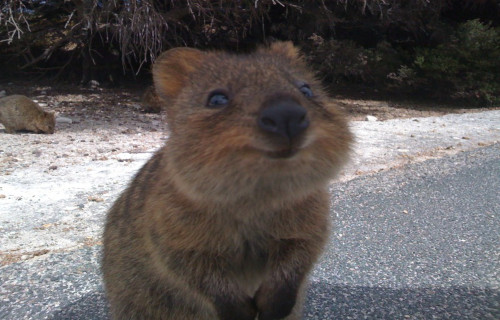
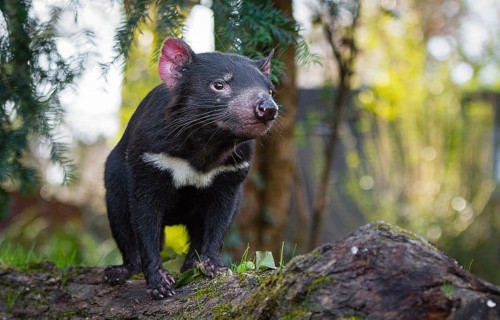
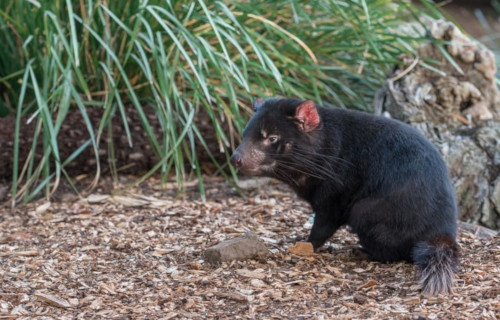
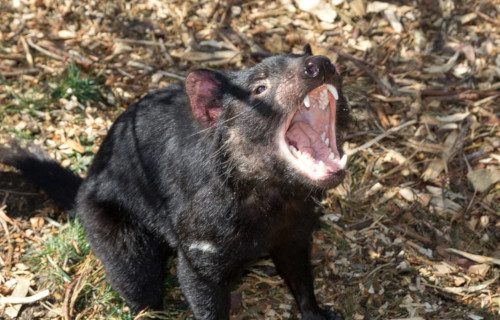
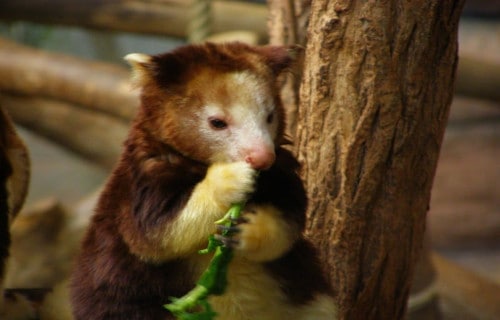
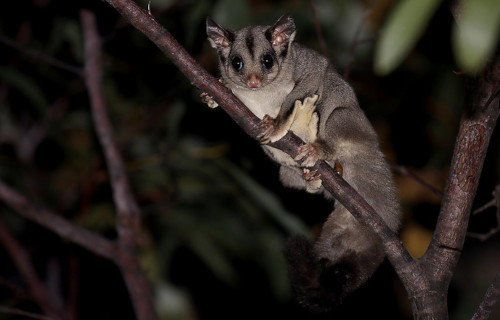
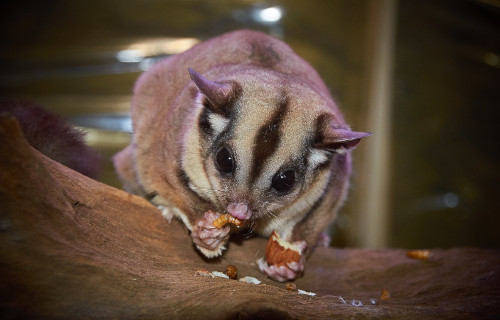
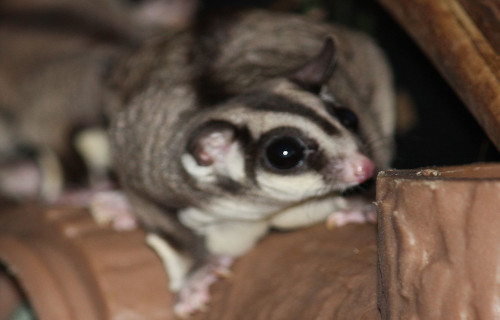
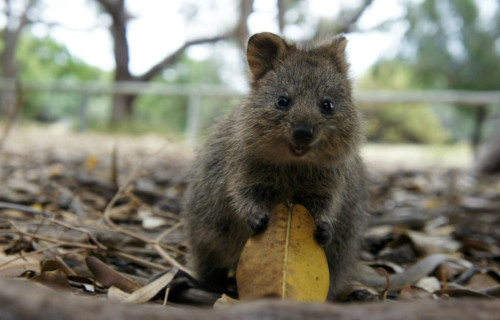
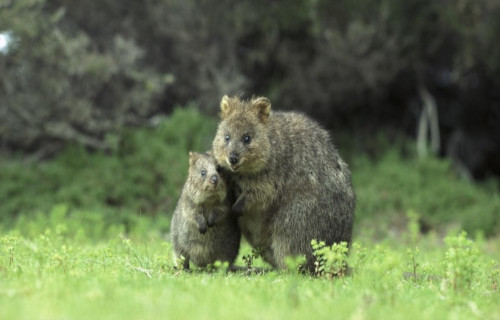
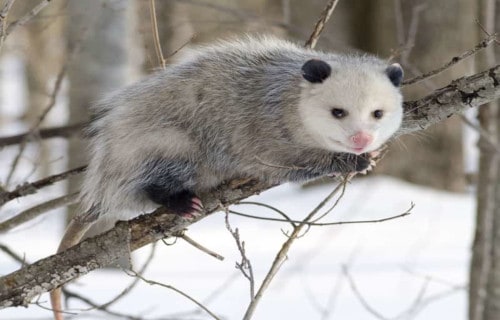
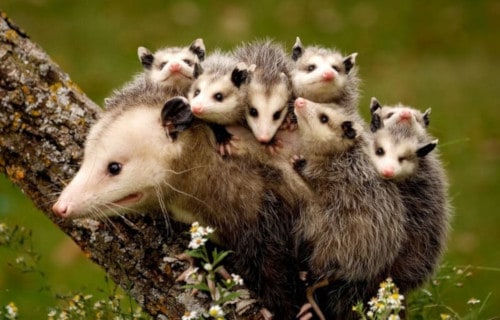
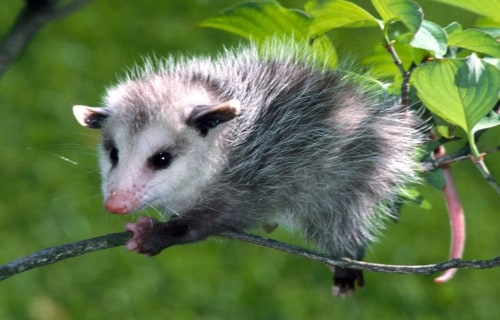
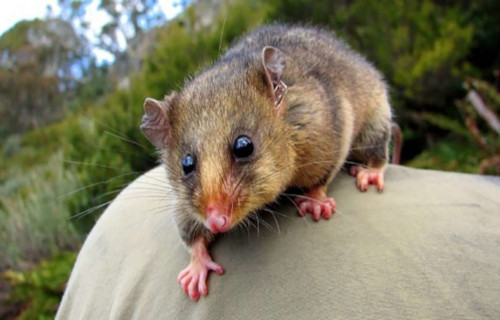
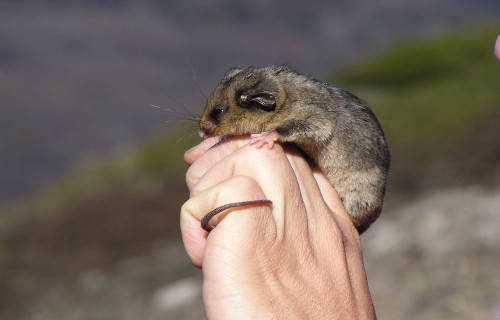
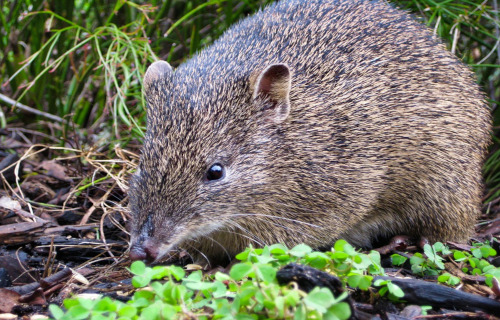

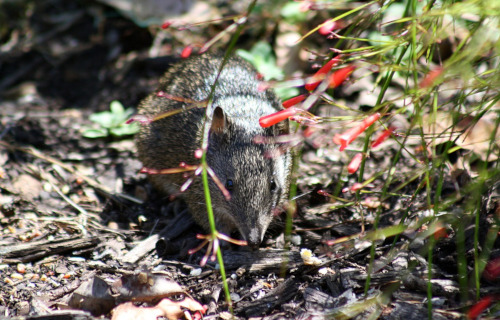
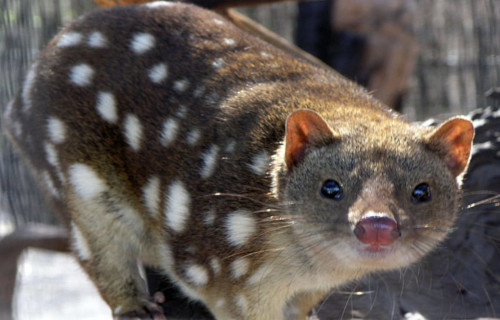
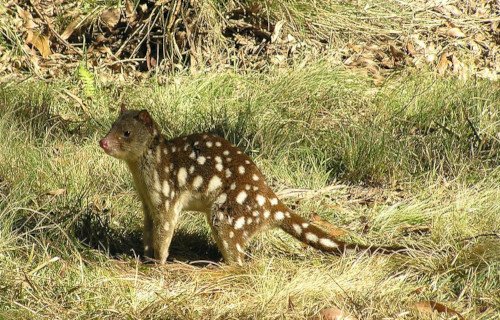
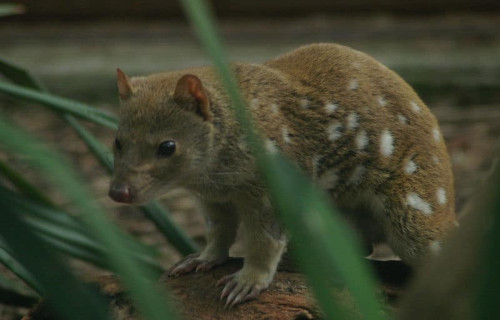
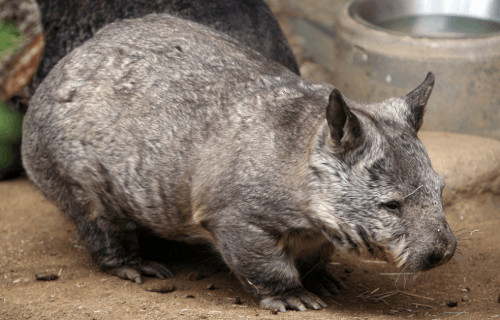
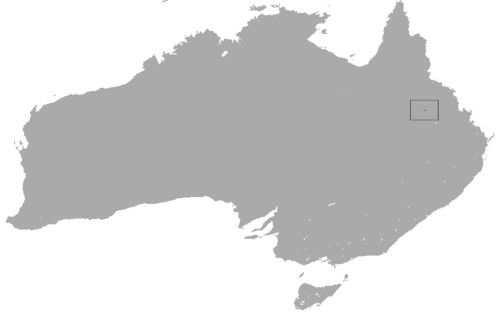









Leave a Reply